by tmoffett | Aug 21, 2012 | Color, Landscape, Photographic Philosophy, Photographic Technique, Uncategorized
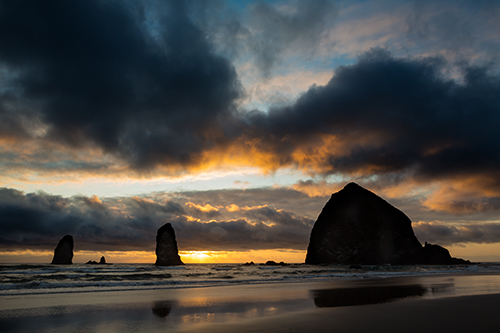
Haystack Rock and The Needles
Recently I was on the Oregon Coast, hoping to photograph some great skies over the ocean. On most of my trips to the coast I have encountered a great deal of fog, which is interesting, but I was looking for something different. Several evenings looked very promising, and then at the last minute fizzled out. On this particular evening, we had a wonderful sunset, for about 2 minutes, and then the sun dropped below the marine layer and all of the color disappeared. I worked hard and fast to position myself to capture this scene, and it made the entire trip worthwhile!
As is so often the case, the light changed so rapidly that I was very thankful to understand the technical side of photography. If I had been relying on the camera to make all of my decisions, I highly doubt that I would have been successful here. With such a high contrast scene, maintaining detail in both shadows and highlights and keeping good saturation in the color is not an easy task. Some would say to shoot several exposures and layer them, or shoot for HDR. Why, when it can be done, in my opinion, better in a single image? I have been and always will be a fan of getting it right in camera. It makes the printing process so much simpler and usually cleaner and sharper.
To really understand photography to the point of creating what my minds eye sees, and doing so almost without thinking has taken a lot of study, practice, mistakes, evaluation, more mistakes, and on and on. All of that time and effort has paid off for me many times over. One of the hardest things to convince my students of is that it is OK to make mistakes. That is how we learn. I still, after 30 plus years of practice, make mistakes. The difference, though, is that I evaluate them and learn from them. They make be better!
by tmoffett | Jul 23, 2012 | Color, Composition, Critique, Landscape, Photographic Technique, Uncategorized
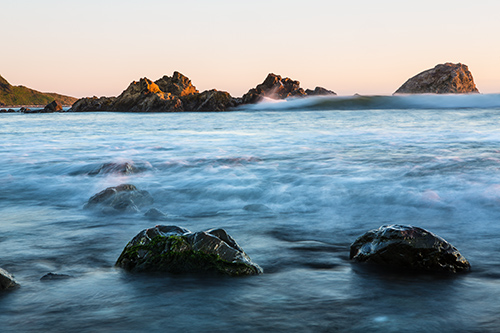
Ocean View, Crescent City, CA
I haven’t been out photographing for a few days and I am starting to get a bit antsy. I have been sitting in front of my computer getting some much needed work done, but I need to photograph. It doesn’t matter that I have a backlog of images to process and other tasks that need worked on, the need to make new images is always there. I guess that means I am a photographer. It is in my blood.
I pulled this image to post from my last trip to the coast. We were in Crescent City, California to photograph the Redwoods, but when I am close to the ocean, I will always find time to spend there. The evening I made this photograph, the sky was naked and colorless, so I really focused on the sea. One thing that I stress in my classes and workshops is to work the camera angles. Many times, especially at the ocean, I find photographers up on the beach, away from the water but shooting the water from a high angle. Not me. I like to be in the water. I try to find a lower angle to shoot from, as this will emphasize the foreground objects better. I have found that if I press my tripod down in the sand it becomes very stable. Unless a big wave slams into the tripod, it is remains quite stable in the water even at long shutter speeds. This image is a 1.3 second exposure, tripod legs buried under about 18 inches of water and waves hitting the tripod legs. The image is still tack sharp. When photographing this way you must keep an eye on the incoming waves, as occasionally a sleeper wave will come out of nowhere and you better be ready to move or risk soaking all of your gear. For this image, I actually wanted to get lower, but when I did, the incoming waves blocked the view of the rocky background too much.
One thing I really like about this image is not only the emphasis on the foreground rocks, but how the low angle also enlarges the size of the wave coming in. The wave creates a nice transition from ocean to rock in the background. I know it is hard to see in the small image here, but the water is packed with texture, detail and subtle color shifts, showing the warm light of the setting sun reflecting off of the highlights, but the deeper parts of the water remain a rich and vibrant blue. There is a lot of life in the finished print.
by tmoffett | Jul 2, 2012 | Color, Ramblings, Random images, Uncategorized
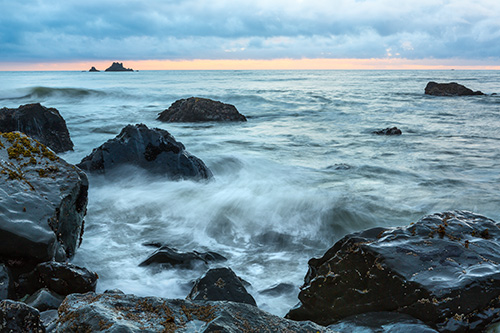
Rocky Shoreline near Crescent City, California
It’s always good to get back home! I have been on the road photographing the Pacific Coast from Crescent City, California to Brookings, Oregon. When I am out, I am on the go from before sunrise to long after sunset, so I really have no time to post. My apologies for those of you that frequently check in. In fact, I am on my way out again this afternoon, but for a shorter trip this time. I will be back to regular posting next week. I have some new images and stories to go along with them.
This image was made on my first evening in Crescent City. It had been stormy all day, but we got just a sliver of light right at sunset that illuminated the coastline while the waves crashed into the rocky shoreline. It was quite a trek getting to water level, as I had to make my way down a steep incline of boulders, but it was well worth it. Never could I have experienced the sea in this way from high above. There is nothing like being right at the waters edge, or even in it at times, attempting to capture a representation of its force, power and beauty.
by tmoffett | Apr 12, 2012 | Color, Landscape, Photographic Philosophy, Photographic Technique, Uncategorized
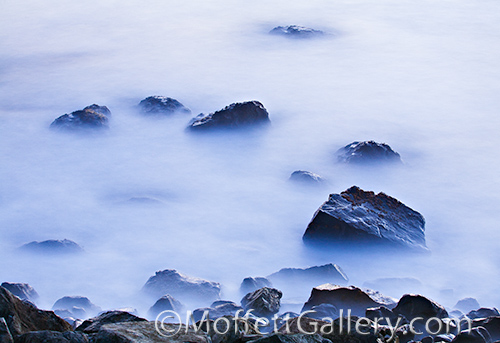
Sea of Mist
I have often said that my favorite time to photograph is just after the sun has set. Well, often I will shoot long after the sun has gone down. This image is one of those times.
It is interesting to me that as many photographers are packing up and going home, I am often just getting started. I like what happens when long exposures capture objects lit with the delicate light coming from the moon. This photograph which is part of my “Shorelines” portfolio, was taken with nearly a 2 minute exposure. The rocks remain tack sharp while the ocean waves crashing ashore become like a sea of mist, soft and delicate. I love how the moisture on the rocks reflects the moonlight and really do look wet, so wet that you can almost feel it when you view the picture. There is also a gentle color shift that I find quite captivating. When I think of the ocean, this is what I see.
If you are a photographer, try not doing a custom white balance sometime. You might just like it! A custom white balance is meant to neutralize the color, making everything look normal, but who is to decide what normal really is. I photograph in this kind of light because of the color, so why would I want to neutralize it? Keeping my white balance in one of the daylight modes will render the colors more closely to how I visualize them instead of removing the color cast caused by the real color of the light that exists, making them appear “normal,” or neutral.
by tmoffett | Dec 7, 2010 | Color, Landscape, Ramblings, Uncategorized
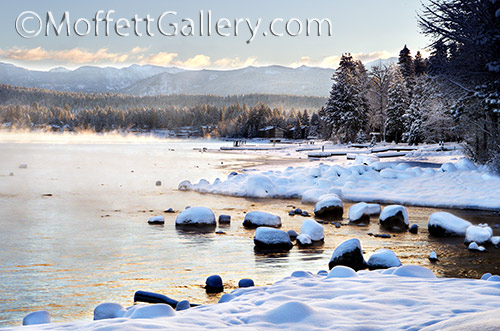
Winter Morning, Payette Lake
Photographing in the winter can be a wonderful experience. It can also be miserable if not prepared. I learned this fact many years ago. The cold of a frozen tripod goes right through the wrong type of glove. Viewfinders fog up if your breath is not directed away from them. Focusing and changing camera settings is nearly impossible with bulky gloves or mittens. However, with clothing that is warm and allows for easy finger movement, photographing in the coldest of temperatures can be quite rewarding.
One cold December morning found us at Shore Lodge in McCall, Idaho. It was a beautiful, but cold morning. It had snowed the night before and all was quiet and calm. We were the first to stamp our footprints in the newly fallen snow as we walked the shoreline behind the resort at sunrise. The light fog lifting from the surface of the lake revealed snow capped rocks rising from the frigid waters. We captured image after image in this winter wonderland for about an hour following sunrise, then headed off to find a hot breakfast and enjoy a relaxing day around town. This was the perfect beginning to a wonderful holiday season!
by tmoffett | Oct 16, 2010 | Color, Composition, Landscape, Photographic Philosophy, Uncategorized
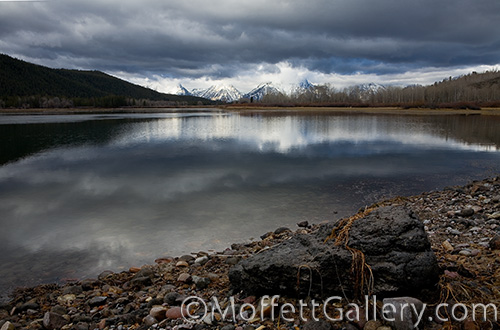
The Tetons
Landscape photography is so much more than just snapping pictures of scenic areas. We must deal with finding a the scene, analyzing composition and working with the light that nature gives us. That doesn’t mean that we make photographs of scenic places under the light that is there when we conveniently decide to be there, wherever there is. It means that we may get up at 4:00 AM and go out in the winter cold in order to arrive and be ready when the morning light first breaks over the horizon. It may mean that we suffer in the late summer heat to find our location and composition and then patiently wait for the setting sun to deliver the quality of light needed to create the mood in our photograph to say what we want it to say. Some days I will set up and wait, only to have the light fizzle out and not deliver. That’s okay. It’s just part of being a photographer.
Learning your craft, really learning it, is a major part of becoming an artist. We must understand the technical aspects of the camera and composition first, and then when photographing from the heart we are able to create masterpieces without having to think logically during the process. We can truly work on an emotional level only when we can work on the technical level without thinking about it. It must become a part of us. I see many students who refuse to learn and master the technical and then wonder why their photographs do not have the emotional impact that they would like. Photography is a blend of art and science, and we must comprehend both if we are to master our craft.








Recent Comments